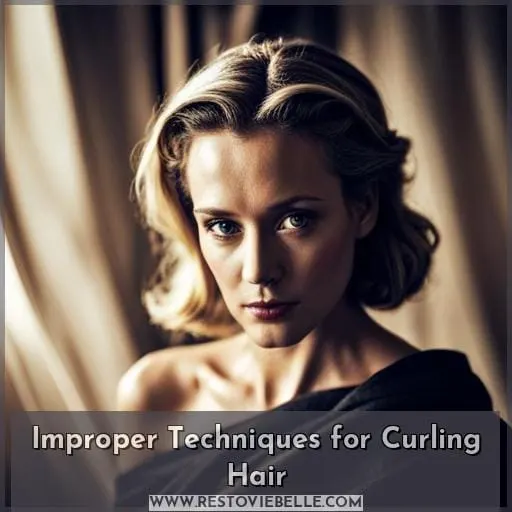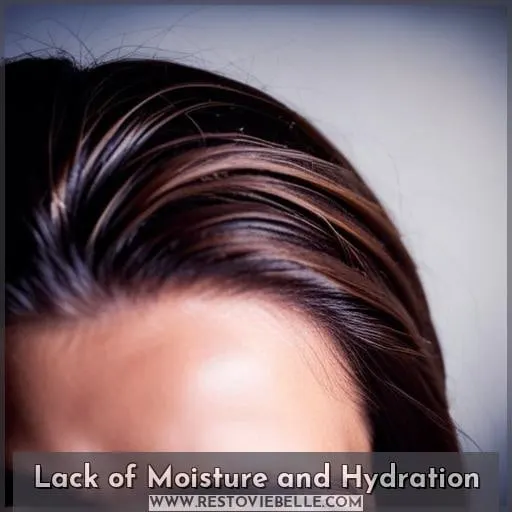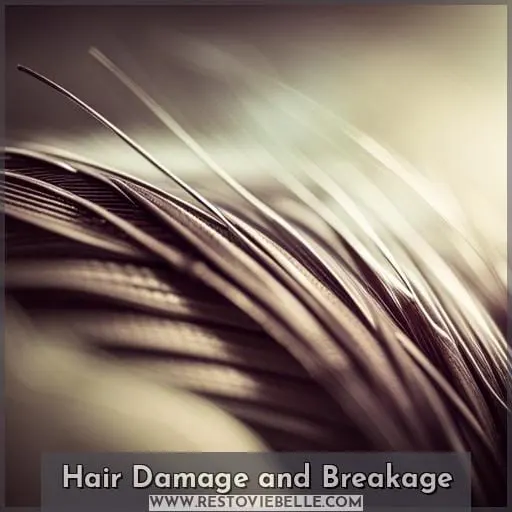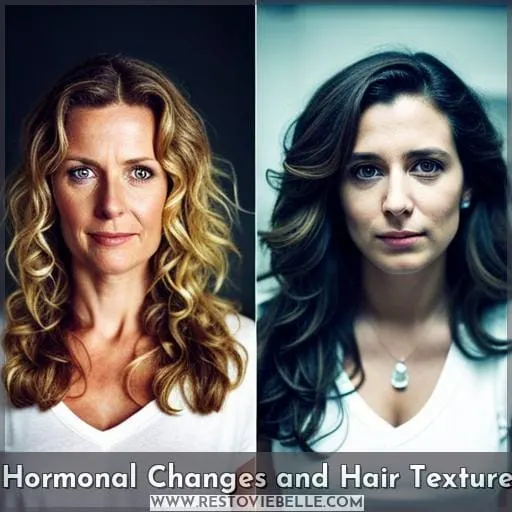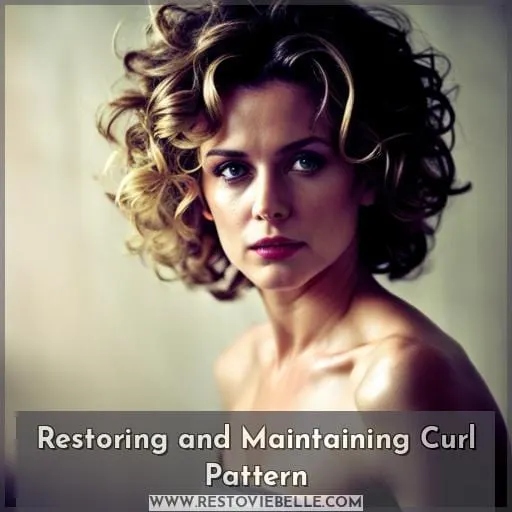This site is supported by our readers. We may earn a commission, at no cost to you, if you purchase through links.
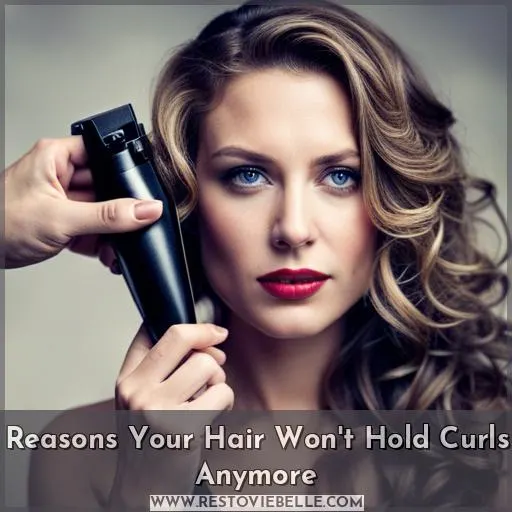 Discover why your hair won’t hold curls anymore and regain control over your locks.
Discover why your hair won’t hold curls anymore and regain control over your locks.
From chemical and heat damage to product buildup and hormonal changes, there are several factors that can affect the longevity of your curls.
Learn about improper techniques, lack of moisture, hair damage, and hormonal imbalances that may be contributing to this issue.
With the right knowledge and strategies in place, you can restore and maintain beautiful curls that last all day long.
Table Of Contents
- Key Takeaways
- Reasons for Losing Curl Pattern
- Improper Techniques for Curling Hair
- Lack of Moisture and Hydration
- Hair Damage and Breakage
- Hormonal Changes and Hair Texture
- Restoring and Maintaining Curl Pattern
- Seeking Professional Help and Advice
- Frequently Asked Questions (FAQs)
- Can using certain hair products cause my hair to lose its curl pattern?
- Are there any natural remedies or DIY treatments that can help restore and maintain my curl pattern?
- Is it possible for hormonal changes to affect the texture and curl pattern of my hair?
- How can I determine if my hair damage and breakage is the main reason why my curls won’t hold anymore?
- When should I consider seeking professional help and advice for my hair’s curl pattern issues?
- Conclusion
Key Takeaways
- Chemical damage, heat damage, and product buildup can cause your hair to lose its curl pattern.
- Improper curling techniques and using the wrong size curling iron can also contribute to your hair not holding curls.
- Insufficient cooling time and excessive touching or brushing of newly curled hair can cause the curls to fall out quickly.
- Lack of moisture and hydration, hair damage and breakage, and hormonal changes can also affect your hair’s ability to hold curls.
Reasons for Losing Curl Pattern
There are several reasons why your hair may be losing its curl pattern.
- Chemical damage from treatments such as hair straightening or bleaching can weaken the hair cuticle and make it difficult for curls to form.
- Heat damage from excessive use of hot styling tools can also cause the hair to become dry and frizzy, affecting its ability to hold a curl.
- Additionally, product buildup or hormonal changes can weigh down the strands and disrupt their natural texture, resulting in less defined curls.
Chemical Damage
One reason your hair can’t hold a curl is because of chemical damage.
Chemical treatments like bleach, color treatments, and relaxers can cause over-processing and hair damage.
Heat styling tools also contribute to curl loss by damaging the hair cuticle.
Heat Damage
If your hair no longer holds curls, it may be due to damage caused by excessive heat styling.
Using the incorrect temperature on your curling iron or not rinsing out products properly can lead to heat damage and a loss of curl pattern.
Product Buildup
Product buildup can be a major culprit when it comes to your hair’s inability to hold curls.
To combat this issue, use clarifying shampoo regularly to remove residue.
Avoid heavy products that weigh down your hair and opt for a dry hairspray formula instead.
Additionally, refrain from touching your curls before they’ve cooled completely.
If you have long or fine hair, consider getting regular trims to prevent excess weight that can affect curl retention.
Hormonal Changes
When experiencing hormonal changes, such as during menopause or pregnancy, your hair’s curl pattern may be affected.
Hormonal fluctuations can lead to hair loss and thinning, resulting in a decrease in the ability of your hair to hold curls.
Improper Techniques for Curling Hair
If you find that your hair won’t hold curls anymore, it may be due to improper techniques when curling your hair.
One common mistake is using the wrong size curling iron. Using a barrel that’s too large or too small for your desired curl can result in curls that don’t last.
Insufficient cooling time and excessive touching or brushing of the newly curled hair can also cause the curls to loosen and fall out quickly.
Incorrect Curling Iron Size
You may be using the incorrect curling iron size if your hair is struggling to hold curls. Using the right barrel size can make a big difference in achieving long-lasting curls.
It’s important to cool your hair completely before touching it and use light products that won’t weigh down your strands.
| Incorrect Curling Iron Size | Proper Techniques for Curling Hair |
|---|
Choose a barrel size that suits your desired curl type and length of hair
Section off small, manageable pieces of hair
Don’t use too large or too small of a barrel as it may not create the desired effect
Wrap each section around the barrel, holding for about 10-15 seconds
Consider using interchangeable barrels for versatility
Release the curled section gently without tugging or pulling on it
Insufficient Cooling Time
To ensure your curls hold their shape, make sure you give them enough time to cool completely before touching or styling further.
Here are three techniques that can help with cooling down your hair for long-lasting curls:
- Use a diffuser:
- Attach a diffuser to your blow dryer and use it on low heat and speed settings.
- This helps distribute airflow evenly while minimizing frizz.
- Use a Denman brush:
- After curling each section of hair, gently comb through the curls with a Denman brush to separate them and allow for better air circulation during the cooling process.
- Scrunch with gel:
- Apply a small amount of curl-enhancing gel to wet or damp hair, then scrunch it upwards towards the roots using your hands.
- The gel will help define and set your curls as they dry.
Remember that patience is key when it comes to cooling down curled hair – resist the urge to touch or manipulate them until they’ve cooled completely!
Excessive Touching or Brushing
Stop excessive touching or brushing your curls if you want them to hold their shape.
- An uneven curl pattern
- Too much product weighing down the hair
- Not enough hold
- Lack of definition
- Hair that becomes too heavy.
By avoiding these habits and adopting proper styling techniques, you can achieve long-lasting and defined curls.
Lack of Moisture and Hydration
One reason your hair may not hold curls anymore is because it lacks moisture and hydration.
Dehydrated hair can become dry and frizzy, making it difficult for curls to form and stay in place.
Insufficient deep conditioning can also contribute to this issue, as the hair needs regular moisturization to maintain its elasticity and ability to hold a curl.
Additionally, overwashing or stripping natural oils from the hair can leave it overly dry and prone to losing its curl retention.
Dehydrated Hair
Dehydration can significantly affect the ability of your hair to hold curls.
Lack of moisture and hydration in your hair can lead to various issues that prevent curl retention.
These include a lack of protein, which is necessary for maintaining the structure and elasticity of your hair, as well as an imbalance between protein deficiency and overload.
Achieving proper protein balance is essential for keeping your curls intact.
Insufficient Deep Conditioning
If you’re finding that your hair won’t hold curls anymore, it could be due to insufficient deep conditioning, which means not providing enough moisture and hydration for your locks.
To address this issue, use a leave-in conditioner after washing your hair and wait at least 45 minutes before styling.
Consider using a diffuser or air drying instead of heat styling tools.
Additionally, always remember to apply a heat protectant spray before using any form of heat on your hair.
Overwashing or Stripping Natural Oils
You’re washing your hair too frequently, which is stripping away its natural oils and causing a lack of moisture and hydration.
Overwashing or using the wrong products can disrupt the balance of your scalp’s natural oils, leaving your strands dry and brittle.
It’s important to find the right balance in terms of how often you wash your hair and what products you use to ensure optimal curl retention.
Hair Damage and Breakage
If your hair won’t hold curls anymore, it could be due to hair damage and breakage.
- Split ends can cause the curl to unravel and make it difficult for the hairstyle to stay intact.
- Overprocessing or chemical treatments can weaken the hair’s structure, making it more prone to breakage and less likely to hold a curl.
- Additionally, if you haven’t been getting regular trims or haircuts, this can lead to split ends and further damage that affects your ability to achieve lasting curls.
Split Ends
To understand why your hair won’t hold curls anymore, it’s important to address the issue of split ends.
Split ends occur when the protective outer layer of your hair becomes damaged and starts to fray. This damage weakens your strands, making them more prone to breakage and preventing them from holding a curl.
To combat split ends, avoid heat styling tools as much as possible, trim your ends regularly, use leave-in conditioners to moisturize and protect your hair, detangle gently with a wide-toothed comb or fingers instead of harsh brushes or combs that can cause further damage, and use gel products specifically designed for enhancing curls while providing hold.
Split ends can be a major culprit behind why our curly hairstyles don’t last long.
When we’ve split ends in our hair strands due to damage caused by various factors such as:
- Heat styling tools like straighteners or curling irons (which should be avoided)
- Chemical treatments like coloring or perming (try opting for natural alternatives if you must)
- Lackluster care regime including infrequent trims causing build-up on top layers leading not just towards frizz but also difficulty maintaining any defined shape like waves/curls etcetera
We need proper hydration too though; using lightweight gels formulated especially targeting their needs will help seal moisture inside each strand so they become less likely break off during manipulation which means better chances at retaining those beautiful bouncy locks longer than before.
Overprocessing or Chemical Treatments
Avoid overprocessing or chemically treating your hair if you want it to hold curls. Chemical treatments can damage the hair and lead to breakage, making it difficult for curls to form and hold.
Here’s why:
- Too much product: Heavy styling products can weigh down the hair, preventing it from holding a curl.
- Hair weight: Overprocessed or chemically treated hair tends to be weaker and more prone to breakage, making it harder for curls to stay in place.
- Styling techniques: Improper styling techniques such as using excessive heat or pulling on the hair too tightly can cause damage that affects its ability to hold a curl.
- Curl cuts: If your haircut isn’t tailored specifically for curly hair, excess weight in the strands may prevent them from forming and maintaining defined curls.
Lack of Trims or Haircuts
If you neglect regular trims or haircuts, your hair is more prone to breakage and will struggle to hold curls.
When the hair is too long, it can become heavy and weigh down the strands, making it difficult for them to maintain a curled shape.
Additionally, lack of moisture in the hair can lead to a damaged cuticle and make it harder for curls to form.
Product buildup on untrimmed ends can also contribute to poor curl retention.
Hormonal Changes and Hair Texture
Are you experiencing changes in your hair texture and finding that it won’t hold curls like it used to? Hormonal changes could be the culprit.
Menopause or hormonal imbalances, pregnancy or postpartum hair changes, and thyroid disorders or medications can all affect the texture of your hair and make it more difficult for curls to hold.
Understanding these hormonal factors can help you find ways to manage your hairstyle better and achieve long-lasting curls.
Menopause or Hormonal Imbalances
If you’re experiencing menopause or hormonal imbalances, your hair’s texture may be affected, making it difficult for curls to hold.
Hormonal changes can alter the structure of your hair and decrease its ability to maintain a curl.
This can be frustrating, but there are ways to work with these changes and still achieve beautiful curls.
Pregnancy or Postpartum Hair Changes
During pregnancy or in the postpartum period, hormonal changes can affect your hair texture and make it more difficult for curls to hold.
These hormonal fluctuations can lead to changes in the thickness, density, and overall texture of your hair.
It’s common for women to experience temporary hair loss during this time as well.
Taking care of your scalp health and promoting new hair growth can help restore your pre-pregnancy curl pattern.
Thyroid Disorders or Medications
When dealing with hair that won’t hold curls, it’s important to consider the potential impact of thyroid disorders or medications on hormonal changes and hair texture.
- Thyroid medication can affect the production of thyroid hormones, which play a role in regulating hair growth and texture.
- Thyroid imbalances can lead to changes in the hair cycle, resulting in thinning or brittle strands.
- Certain medications used to treat thyroid problems may also have an impact on hair quality and curl retention.
- Surgical procedures such as thyroidectomy can disrupt hormone levels and potentially affect the ability of your hair to hold curls.
Restoring and Maintaining Curl Pattern
To restore and maintain your curl pattern, there are several key points to keep in mind.
Firstly, using a clarifying shampoo can help remove product buildup that weighs down your hair and prevents curls from forming.
Secondly, employing proper styling techniques and tools such as diffusers or satin pillowcases can enhance curl definition and reduce frizz.
Lastly, regular trims and maintaining a consistent haircare routine will promote healthy hair growth while preserving the integrity of your curls.
Clarifying Shampoo and Scalp Care
To restore and maintain your curl pattern, it’s important to incorporate clarifying shampoo and scalp care into your haircare routine.
Clarifying shampoos help remove product buildup from the hair without stripping it of its natural oils. Look for shampoos that are sulfate-free and use them sparingly to prevent excessive drying.
Proper scalp care also helps balance the scalp’s pH levels, preventing buildup that can weigh down the hair and affect its ability to hold curls.
Proper Styling Techniques and Tools
To restore and maintain your curl pattern, it’s important to use proper styling techniques and tools.
- Use a diffuser when drying your hair to enhance the natural curls.
- Rinse with cold water after conditioning to seal the cuticle and promote shine.
- Apply a leave-in conditioner before styling for added moisture and definition.
- Consider plopping or air drying instead of using heat tools for healthier curls.
Regular Trims and Haircare Routine
To maintain your curl pattern and ensure that your hair holds curls, it’s essential to:
- Incorporate regular trims every 6-8 weeks.
- Establish a consistent haircare routine.
- Deep condition weekly to restore moisture.
- Avoid heavy products that weigh down the hair.
- Use a diffuser when styling with heat.
- Sleep on a silk pillowcase for reduced friction.
Seeking Professional Help and Advice
If you find that your hair is no longer holding curls, it may be time to seek professional help and advice.
Consulting a curl specialist can provide valuable insight into the specific needs of your hair type and help determine any underlying issues that may be causing the problem.
Additionally, professional hair treatments and services such as deep conditioning or protein treatments can restore moisture and strength to your strands, improving their ability to hold curls.
Finally, a curl specialist can create customized haircare plans and recommendations tailored specifically for you, ensuring long-lasting results with beautiful curls.
Consulting a Curl Specialist
If you’re struggling with your hair not holding curls anymore, it may be time to consider consulting a curl specialist for professional help and advice on how to restore and maintain your curl pattern.
- Find a curl specialist near you
- Understand what to look for in a curl specialist
- Prepare questions to ask during the consultation session
Professional Hair Treatments and Services
You’re often wise to seek professional hair treatments and services when struggling to maintain your curl pattern. Having a consultation with a curl specialist can provide invaluable advice on the best products, techniques, and services to restore your curls.
| Treatment | Benefit | Frequency |
|---|---|---|
| Deep conditioning | Hydrates and repairs | 1-2x monthly |
| Corrective trims | Removes damage | Every 6-8 weeks |
| Botox treatment | Strengthens and smooths | As needed |
Incorporating professional-grade treatments, coupled with at-home care, can get your curls bouncing once again.
Customized Haircare Plans and Recommendations
You’ll also want to seek out customized haircare plans and recommendations from curl specialists to address your unique hair needs and challenges.
Experts can assess factors like your hair porosity and determine if gentle styling, protein treatments, leave-in conditioners, or co-washing may help restore your curls.
Frequently Asked Questions (FAQs)
Can using certain hair products cause my hair to lose its curl pattern?
Yes, certain ingredients may build up on hair over time, causing damage that impedes curl formation.
Avoid prolonged use of products with drying alcohols or heavy oils.
Occasionally clarifying hair allows curls to rebound.
Are there any natural remedies or DIY treatments that can help restore and maintain my curl pattern?
To restore and maintain your curl pattern, consider nourishing your hair with natural remedies like coconut oil or aloe vera. These potent ingredients can help hydrate and strengthen your strands, giving you the power to reclaim those bouncy curls.
Is it possible for hormonal changes to affect the texture and curl pattern of my hair?
Hormonal changes can indeed impact the texture and curl pattern of your hair.
Fluctuations in hormone levels, such as during pregnancy or menopause, can alter the structure of your hair follicles, resulting in changes to its natural curl.
How can I determine if my hair damage and breakage is the main reason why my curls won’t hold anymore?
To determine if hair damage and breakage is causing your curls to lose their hold, examine the condition of your strands for signs of split ends, dryness, or excessive shedding.
When should I consider seeking professional help and advice for my hair’s curl pattern issues?
When persistent problems styling and damage occur over weeks or months despite your best at-home efforts, consider booking a consultation.
A stylist can assess your hair’s needs, explain what’s causing issues retaining curls, and suggest customized solutions so you can regain control.
Conclusion
Regain control over your curls by:
- Clarifying and moisturizing your hair
- Using proper styling techniques
- Getting regular trims
- Consulting professionals
Address reasons your hair won’t hold curls anymore like:
- Damage
- Buildup
- Improper curling
- Hormonal changes
Ultimately, with the right strategies for your hair type and needs, you can restore, maintain, and enjoy beautiful lasting curls.

